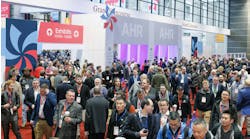Latest from Home
5 Times When Your Business Can Celebrate
AHR Expo 2025 Returns to Orlando
Sponsored
APPLE VALLEY, MINN. — Dates for Uponor’s 2009 radiant webinar schedule, covering thermal comfort, radiant heating and cooling, snow and ice melting, frost prevention, the human factor in HVAC, and radiant-based HVAC systems and snow melt, were recently announced and will be hosted by Robert Bean, a registered engineering technologist in construction engineering technology and radiant heating and cooling.
“These webinars are a useful tool for professionals looking to expand their knowledge of indoor environments and energy efficiency,” said Bean. “In fact, there has never been such a critical time in architecture, where the application of knowledge gained today through affordable AIA/CES programs could have lasting benefits on future generations.”
The webinars are for industry professionals interested in developing their education and careers in the radiant heating and cooling market. Attendees will earn Learning Units for professional development, as required by the American Institute of Architects/Continuing Education System, as well as Professional Development Hours, as required by the American Society of Heating, Refrigerating and Air-Conditioning Engineers.
Architects can earn one AIA LU by attending the thermal comfort, radiant heating and cooling, snow and ice melting, or frost prevention webinars.
The thermal comfort webinar addresses the basics of human physiology as it relates to thermal sensations and health, safety and wellness. Topics include specifications for interior thermal conditions to meet the parameters of ANSI/ASHRAE Standard 55 and the relationship between indoor comfort and indoor air quality with reference to ANSI/ASHRAE Standard 62 — Ventilation for Acceptable Indoor Air Quality.
The radiant heating and cooling webinar discusses how radiant-based heating and cooling systems influence health, wellness and safety in the context of industry codes and standards. Topics include radiant heating and cooling terminology; types of radiant surfaces and sub-assemblies; and basic mechanical equipment and thermal design criteria for radiant-conditioned spaces.
The snow and ice melting webinar covers common snow and ice melting applications — walks, ramps, drives, helipads, stairs — and how to evaluate and meet client needs and performance expectations in these areas. The course will also address the required design criteria for evaluating thermal-melting loads.
The frost prevention webinar focuses on creating safe conditions for facility users and onsite employees by preventing structural damages, which can result from frost heaving in sports facilities or in cold-storage buildings. This includes the prevention of frost in building slabs under skating/curling ice surfaces, food freezers/food storage and warehouses.
Subject to local chapters, engineers can earn one ASHRAE professional development hour by attending human factor in HVAC, radiant-based HVAC systems and snow melt webinars.
The human factor in HVAC reviews influencers affecting wide-scale adaptation of indoor environmental quality into the built environment. It includes a brief study in demographics and socioeconomic conditions, and presents solutions based on health and wellness, supported by a basic study in thermal comfort, ASHRAE 55, and indoor air quality, ASHRAE 62.
Radiant-based HVAC systems covers the basics of incorporating radiant into the design of buildings and HVAC systems. It includes a brief history of radiant as well as a look at relevant ASHRAE standards as they pertain to indoor environmental quality.
The webinar discusses design tools, such as FEA and thermography, which lead into human design factors as they relate to ASHRAE 55 and 62. The presentation concludes with a look at design processes and instrumentation for studying radiant heating and cooling systems.
The snow melt webinar covers design principles based on client, control, construction and calculation. It includes a study, using industry software, of how storm characteristics influence design, performance and operating costs.
Additional information and the webinar schedule is available at: www.uponor-usa.com/training.

